How Windows and Linux Can Work Together in Diverse Environments
The Windows Subsystem for Linux or Windows WSL is a not bad solution for developers to natively work within Linux right on their Windows 10 version desktop.
If y'all've spent way likewise much time partitioning hard drives to have several Linux systems installed with Windows, yous're in luck with this article.
The fairy code-female parent at Microsoft has decided to requite you another option: The Windows Subsystem for Linux (WSL). WSL makes running a Linux system alongside Windows and so much easier, and more flexible.
In this tutorial, you lot'll learn how to go started with WSL. You'll larn how to become started to learning how to utilize some nifty tools making WSL even more than versatile than using fustigate or PowerShell on their own.
What is WSL?
WSL or C:\Windows\System32\wsl.exe is a Windows tool that allows you to install a Linux distribution as an app from the Windows store.
Since WSL is a simple Windows executable, you lot can phone call information technology from a command prompt or PowerShell terminal. Nosotros'll go deeper into that topic later. For at present, it's of import to empathize a little more almost what WSL is doing under the hood.
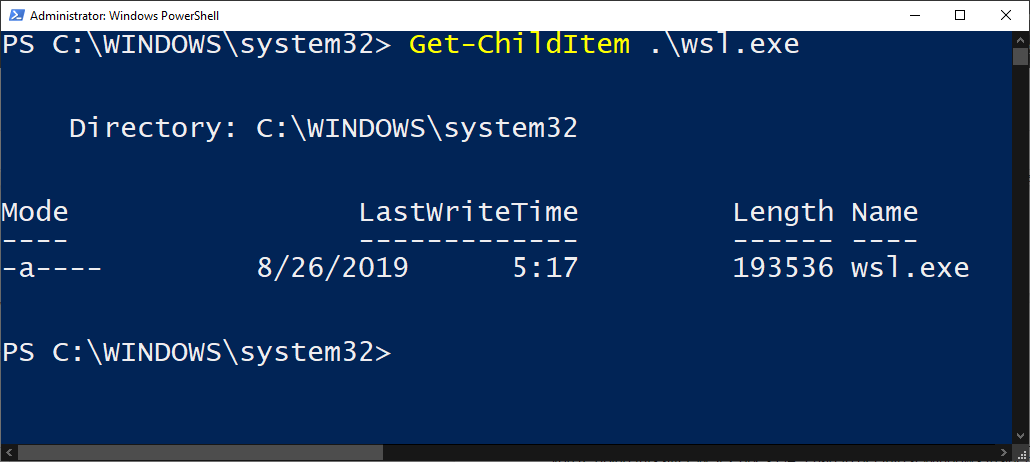
How to Enable WSL
To set up and enable WSL involves installing a Linux distribution alongside Windows 10. But in a fashion that allows the 2 unlike operating systems to interact with each other.
Prerequisites
To install WSL on Windows, y'all have i requirement to encounter; you must have a Windows 10 64-bit computer Build 18917 or afterward.
Yous can find your Windows 10 build past running the winver utility.

Enabling the WSL Windows Characteristic
WSL is a cinch to enable; no download required. It'south merely a single Windows characteristic.
To enable WSL, open up up PowerShell as administrator and run the following:
Enable-WindowsOptionalFeature -Online -FeatureName Microsoft-Windows-Subsystem-Linux Related: How to Run PowerShell as Administrator
Once complete, restart your computer and you're done!
Downloading a Linux Distribution for WSL
WSL does non install any Linux distribution on its own. You'll need to install one. One time Windows 10 comes back up, starting time setting upward your chosen Linux distribution.
First, open the Microsoft Store and search for 'WSL'. You should soon run across a list of Linux distributions bear witness upwards.

Adjacent, cull your distribution of selection and install it. This tutorial volition be using Ubuntu 18.04. At the time of this writing, you have a few other distributions available likewise such equally:
- Ubuntu 16.04 LTS
- Ubuntu 18.04 LTS
- OpenSUSE Leap 15
- OpenSUSE Jump 42
- SUSE Linux Enterprise Server 12
- SUSE Linux Enterprise Server 15
- Kali Linux
- Debian GNU/Linux
- Fedora Remix for WSL
- Pengwin
- Alpine WSL
Setting your WSL Version
You might have to enable Linux to work with WSL version two. If so, y'all can do so past following the beneath instructions.
In a PowerShell console:
- List which versions of Linux you have installed by running
wsl -lorwsl --list. - One time yous take the list, re-create the name of the distro you want to run with WSL2 and run
wsl --set-version <Distro> 2, replacing <Distro> with the name you copied before. - Confirm the command was successful by running
wsl -fifty -fiveorwsl --list --verbose. This command will render a full list of WSL distros and the version each distro is using.

You lot can besides fix your default WSL version for whatever distros you install in the future to WSL2 by running
wsl --fix-default-version 2
Starting up WSL
To beginning using WSL, open up up a PowerShell terminal and type wsl. If you've gear up upward WSL correctly, you lot'll enter a bash terminal running on the WSL distro of pick. From here, you can run whatever Linux commands you lot wish.
Beneath you will find a reference to all of the options the wsl.exe provides when starting upwardly.
| Command | Explanation | Example |
|---|---|---|
| exec, -e | Volition run control using without using default shell | wsl -eastward curl google.com |
| — | Passes anything later this parameter to default shell. Leaving the operator out will also work. | wsl — roll google.com, wsl curl google.com |
| distribution, -d | Opens a terminal in the specified distribution's shell | wsl -d Ubuntu-18.04 |
| user, -u | Runs WSL command as the specified user every bit long as user exists on that distro | wsl -d Ubuntu-xviii.04 -u tux_user |
| export | Exports the specified distribution to a tar file on your local system. | wsl –export Ubuntu ./Test-Ubuntu.tar |
| import | Imports a tar file every bit a new WSL distribution. Can specify WSL version with the –version option | wsl –import Examination-Ubuntu C:\data\Test-Ubuntu .\Test-Ubuntu.tar |
| list, -l [Options] | wsl –list | |
| all | List all installed WSL distributions | wsl -l –all |
| running | List but WSL distributions that are currently running | wsl -l –running |
| tranquillity, -q | Only prove WSL distribution names | wsl -l -q |
| verbose, -v | Show detailed information nearly all WSL distributions | wsl -l -five |
| set-default, -s | Sets the specified WSL distribution every bit the default distribution for WSL commands. | wsl -s Test-Ubuntu |
| prepare-default-version | Changes the default WSL version for all new distributions installed to that organisation | wsl –set-default-version two |
| gear up-version | Changes the WSL version of the specified distribution | wsl –set-version Exam-Ubuntu two |
| shutdown | Immediately terminates all running WSL distributions | wsl –shutdown |
| end, -t | Terminates the specified WSL distribution | wsl -t Exam-Ubuntu |
| unregister | Unregisters the specified WSL distribution | wsl –unregister Test-Ubuntu |
| help | Brandish information about using WSL | wsl –help |
Once you lot become comfortable using these switches, you'll find that running and managing applications through WSL is much easier than managing Linux virtual machines on your own.
Quick tip: Notice all flags and arguments for to WSL past running
wsl --help.
When you're finished, type exit to go dorsum back to the PowerShell concluding.
Sharing Windows/Linux Resources via WSL
One of the best parts of WSL is that it can seamlessly share Windows and Linux resources with each other. At this fourth dimension, you tin share file systems, environment variables, network resources, and command-line tools like cmd and PowerShell.
All examples you will see in this section are via the WSL Ubuntu Linux distro. Your mileage may vary if you've chosen to download a different distro.
Sharing File Systems
The file organisation is one of the most useful things to share with WSL. WSL allows you lot to piece of work with both file systems as if they were ane.
The Windows 10 file organisation is mounted as a directory in Linux while your Linux file system will be mounted as a binder in Windows.
Finding the Linux File System from Windows with Environment Variables
When you install a Linux distro with WSL, it will sometimes add a Windows surround variable. In the example of the WSL Ubuntu Linux distro, it will create an environment variable called UBUNTU_HOME. This surround variable points to the Linux /dwelling house/ubuntu directory from both Windows and WSL Ubuntu.
The path defined in UBUNTU_HOME can exist used to run scripts that use resources across them, or set a default location for the Windows terminal (covered later on).

Other distros may define a similar environs variable. Inspect the Windows surround variables with the PowerShell command Get-ChildItem -Path $Env:\ after installing a new Linux distro to see if any may have been added.
This surround variable shortcut is handy if y'all desire to put everything in the /domicile/ubuntu directory. But let'south dig a little deeper into how it got there and how else you lot can achieve it.
Finding the Linux File Organisation from Windows via the Microsoft Store Packages Folder
Not every WSL distro is guaranteed to come with an piece of cake manner to reference it. Information technology'due south important that y'all larn how to find the Linux file system an alternative mode.
Since most WSL Linux distributions will be installed from the Microsoft shop, you tin look for the Linux file system in the same place equally other Windows store apps. Navigate to %USERPROFILE%\AppData\Local\Packages\ to observe the directory where your Windows store apps get. Then assume command of the folder as this is usually protected by default.
You will encounter many subfolders in the packages folder where your Linux distrubution file system may be presented. The WSL Ubuntu distro, for case, was under the CanonicalGroupLimited.Ubuntu18.04onWindows_79rhkp1fndgsc folder for me.
If you navigate into the package binder, you will discover the Linux file system. For WSL Ubuntu, it's located in the LocalState\rootfs folder. This is the root directory of your Linux distro.
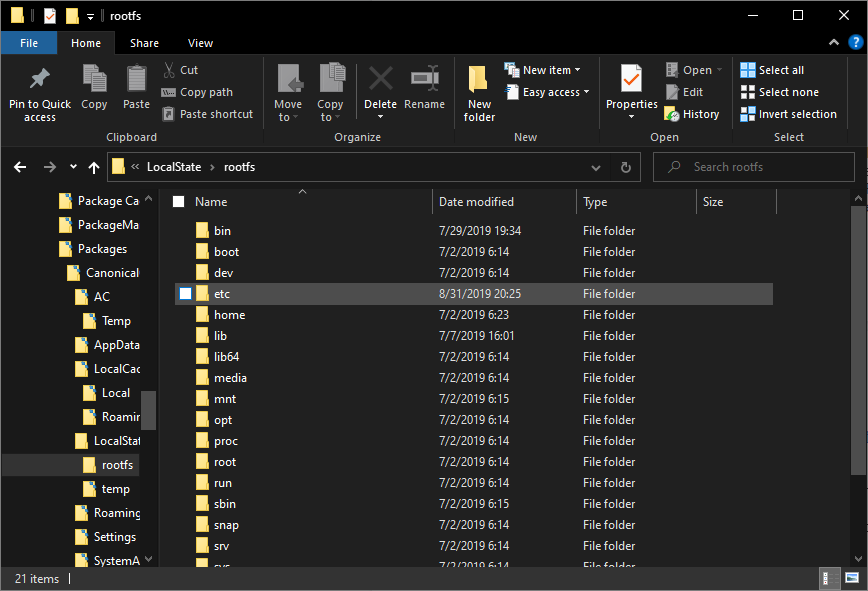
Finding the Windows File System from Linux
To find the Windows 10 file organization from Linux, open up WSL in Windows. WSL will then bring up a bash terminal. This fustigate last will offset in your UBUNTU_HOME directory by default.
You tin can also find the root of your Windows storage volumes likewise. Each of your Windows letter drives (C, D, Due east, etc) is treated equally a mounted drive from the WSL Linux file system. You'll observe each volume mounted as /mnt/c, /mnt/d, etc equally long as you have root privileges.

Get-ChildItem C:\Windows\System32 | Select-Object -First v running on WSLThe WSL2 Filesystem
Navigating the WSL filesystem is fairly straightforward. Anyone non familiar with a Linux file system construction volition capeesh being able to navigate it with the Windows Explorer. Bu if you want to switch to WSL2, it's going to exist a little more complicated.
WSL2 changes how everything works under the hood for sharing file systems. For starters, the filesystem is at present a virtual hard disk drive in vhdx format instead of a directory.
Yous can find the vhdx file under %USERPROFILE%\AppData\Local\Packages\CanonicalGroupLimited.Ubuntu18.04onWindows_79rhkp1fndgsc\LocalState for an WSL Ubuntu distro.
Y'all'll observe that VHDX files tin can be mounted in Windows with the Deejay Manager tool. But, the virtual disks cannot be mounted while the WSL distro is registered.
Sharing Environment Variables
Environment variables are a crucial function of any operating system, making information technology piece of cake to reference binaries and executables anywhere in your applications.
Before Windows 10 build 17063, the only environs variable shared between Windows ten and WSL Linux was the PATH variable. Since then it is possible to share surround variables by using WSLENV the environment variable.
Using the WSLENV surround variable to share other surround variables can feel a petty meta. To share environment variables beyond platforms, you really have to set environs variables inside of some other environment variable.
Overview
Sharing surround variables is a three-step process below. The only major departure when sharing across Windows/Linux is the switch argument used (full reference below).
- Define environment variable in Windows or Linux.
- Gear up the WSLENV environment variable equal to the previously defined surround variable followed by a switch argument (for path translation).
- Read the environment variable in Windows or Linux.
Sharing Options
You tin make variables available four different means depending on which platform you'd like the environment variable to show upwards on using switches (tabular array shown below).
- Windows filesystem to only be available from itself
- WSL filesystem to merely exist available from WSL
- WSL filesystem to exist available on both WSL Linux and Windows
- Windows filesystem to be be available on both WSL Linux and Windows
| Flag | Explanation |
|---|---|
| /p | Single path. A variable set with this volition be translated betwixt the Windows and WSL Linux and made available to both. |
| /50 | List of paths. Similar to /p, except it can accept more than 1 path. On Windows, this list will be delimited past semicolons while on WSL Linux it will be delimited by colons. |
| /u | Unix path. A path set with this flag can only be accessed when invoking WSL Linux from Windows. Tin be used with either the /p or /l flags |
| /w | Windows path. A path set with this flag tin can simply be accessed when invoking Windows from WSL Linux. Can be used with either the /p or /l flags |
Path Translation
The primary reason to share environment variables is for path translation. Every bit y'all may already know, Windows has user profile folders as Linux has user contour directories, for example. Each user has a predetermined "habitation folder" like C:\Users\<username> on Windows and /home/<username> on Linux.
Using the /p and /l switches, the WSL will interpret these folder paths betwixt platforms.
Sharing and Translating Windows Paths with Linux
You can share a unmarried path or multiple paths at in one case using the /p and /l switches.
At a Windows control prompt and with a Windows environment variable divers called DESKTOP, assign a value of DESKTOP/p to the WSLENV variable. This allows you to admission it from WSL Linux. You can see an case below.

The exact same procedure can be performed for multiple paths at one time using the /50 switch.
Sharing and Translating Linux Paths with Windows
To share and translate Linux path with Windows is the same procedure equally information technology Windows although using Linux-specific commands to set environs variables.
For a deeper wait at sharing environment variables, cheque out, this Microsoft article.
Sharing Network Resources
The networking component is another handy resource to share between Windows and WSL Linux.
Physical vs. Virtualized Network Interfaces
In WSL2, the network interfaces are virtualized. Virtualized network interfaces mean that WSL2 network instances can agree different IP configurations than their Windows 10 counterparts.
At the time of this writing, IP addresses for WSL2 Linux use Network Address Translation (NAT) to admission network resources on Windows, though Microsoft has mentioned removing NAT is loftier on their backlog of issues to fix.

Client DNS Resolution
WSL will all the same both generate /etc/resolv.conf and /etc/hosts files to let for DNS resolution. As long as you don't explicitly override that beliefs in /etc/wsl.conf, client DNS resolution volition continue to work as expected.
You'll learn more about the wsl.conf file later in the post.
Using PowerShell and Bash Together
One of the coolest features of WSL is the ability to seamlessly pass information to and from PowerShell and Fustigate on WSL.
PowerShell –> Bash
Since the WSL executable accepts input from the pipeline, you tin call the wsl.exe control inside of PowerShell and have stdin. This allows you to use WSL to pass unabridged objects from PowerShell into the WSL which then get candy with the bash terminal. You can see an case below.

grep Bash –> PowerShell/Cmd
You can also laissez passer data from bash in the WSL to PowerShell and cmd but as easily. Below you lot tin can see an example of executing the Linux ls command and passing the output to the PowerShell Select-Object cmdlet via the pipeline.
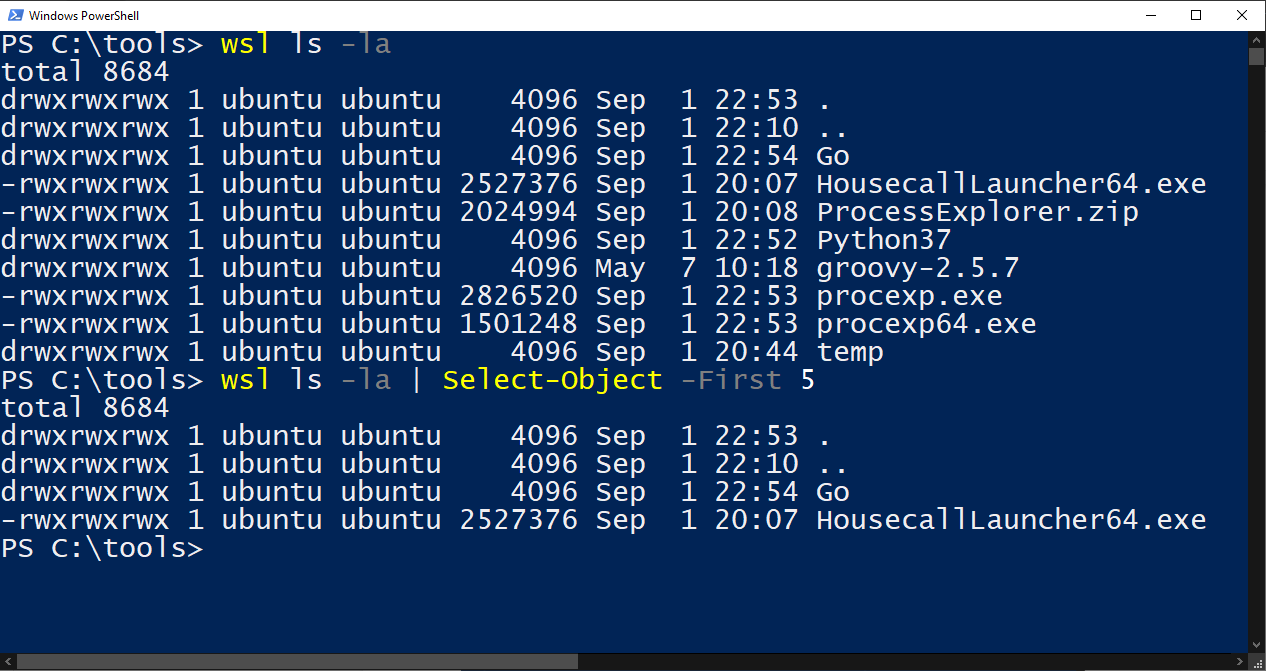
Yous tin can as well call some Windows cmd utilities from the WSL and pass the output back to Linux as long every bit both commands are in the organization path.
Call back that the WSL knows what the system path is on both sides because it has admission to the Windows PATH variable by default
Below you can see that you tin can run ipconfig, which is a Windows command, from within the WSL and laissez passer that output to the Linux grep command. You can also run into the opposite of calling the Linux command which and passing output to the Windows ipconfig control.

Translation Issues
There are some caveats to passing command output dorsum and forth between bash and PowerShell.
1 big problem is how PowerShell and fustigate return data. PowerShell is an object-oriented programming linguistic communication while bash is a string manipulation tool. Any PowerShell objects piped to bash volition flattened as a cord. Conversely, any bash output piped to PowerShell will exist converted to a string object.
You can become around the behavior somewhat past converting or explicitly casting object types in PowerShell like in the example below. But if you are expecting to laissez passer objects betwixt PowerShell and WSL without any extra piece of work, you're going to be disappointed.
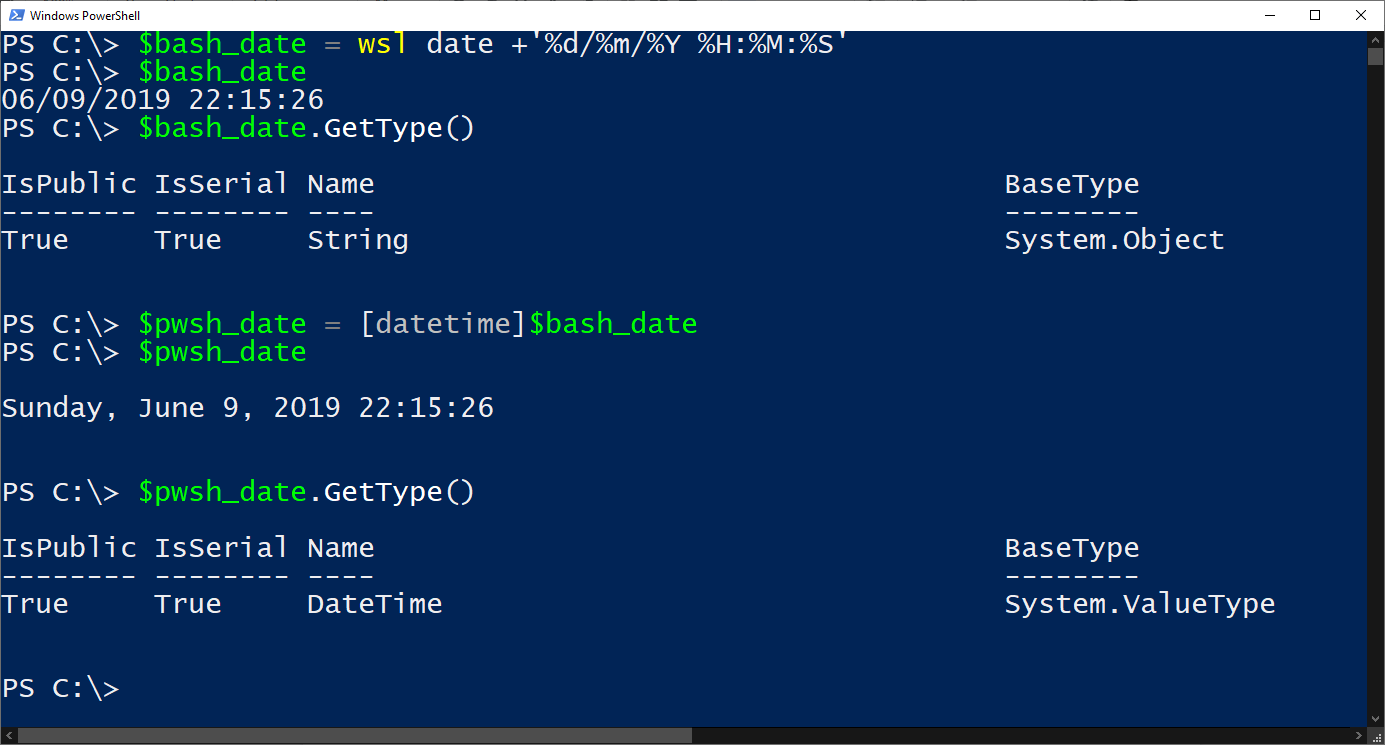
Past casting the bash date as the [datetime] class in PowerShell, now nosotros accept a valid PowerShell object that we can use in our script. If you are writing scripts that need to go from Windows to WSL and back over again, information technology's possible to practice with a footling massaging to the lawmaking.
Install a Windows Subsystem for Linux GUI with Xfce4
When command-line tools aren't enough, it's time to break out the GUIs. If you need to run a graphical utility on WSL, explore a custom distro, or you're not familiar with fustigate nonetheless, you can install a Linux GUI.
Xfce
Linux has many available desktop environments. 1 of the most common ones to gear up for WSL is called Xfce. At the time of this writing, Xfce is at version 4. Other desktop environments are available but in this article, you'll learn how to get Xfce4 set upwards.
xRDP
When y'all accept a Linux desktop environment set, you'll need a service that understands the RDP protocol. In this article, nosotros'll focus on the xRDP server. xRDP is an open source RDP server for Linux that allows y'all to utilize RDP clients to connect to Linux simply as if you tin Windows hosts.
Setting Up
To access a Linux GUI from Windows with Xfce4 and xRDP, follow the instructions below. In a WSL terminal:
- Download and install Xfce4 – Download and install Xfce4 using the command
sudo apt-become -y install xfce4 && sudo apt-get -y install xubuntu-desktop. This will accept a while. Stand up by. - Install the xRDP server – Download and install xRDP by running
sudo apt-become -y install xrdp. - Configure xRDP for xfce4 –
repeat xfce4-session > ~/.xsession - Restart xRDP –
sudo service xrdp restart - Find the WSL distro IP address –
ifconfig | grep inet
At this point, you should be able to open an RDP session from Windows 10. Open up remote desktop connection window using mstsc and provide the Linux IP address found in step #five.
If all goes well, you can open up an RDP connection to the Linux distro that'southward running on your Windows operating system as shown below.

Tips and Tricks
Now that you know the basics of WSL and how to use it, what's next? Fortunately at that place are a lot of tools that are either congenital for or work well with WSL.
Setting WSL Configuration Items at Bootup with wsl.conf
A configuration file exists in the WSL at /etc/wsl.conf. This file contains configuration settings that run every time the WSL distro is started. When the wsl.conf file exists, WSL will ingest whatever setting in this file every time the Linux distro is started.
There are a few different sections inside of the wsl.conf file you tin can configure.
- Automount – Mounting drives from Windows at start
- Network – Generate resolv.conf or the hosts file
- Interop – Enabling or disabling interop with Windows
For more details on the wsl.conf file, bank check out the Microsoft Ready WSL Launch Settings page.
Developing on WSL with Visual Studio Lawmaking (VS Code)
VS Code seemingly integrates with everything and WSL is no exception. From within VS Code, you lot can set a workspace on your WSL Distro but dispense it completely with VS Code on Windows. You lot don't even demand to have a final running!
To set VS Lawmaking on Windows to work with WSL, you'll get-go obviously need VS Lawmaking for Windows installed. Also be certain you have the Remote – WSL VS Code extension installed.
Once you've got the extension installed, y'all can at present connect to it by opening a WSL last and running code <workspace>.<Workspace> is the directory where yous'd like to run VS Code from. VS Lawmaking will so detect that you are in a WSL distro, open up a window, and plant a connexion to to the workspace.
Confirm it worked past noticing the WSL connection icon in the lower left corner of VS Code. You should see that it has the name of your WSL distro.
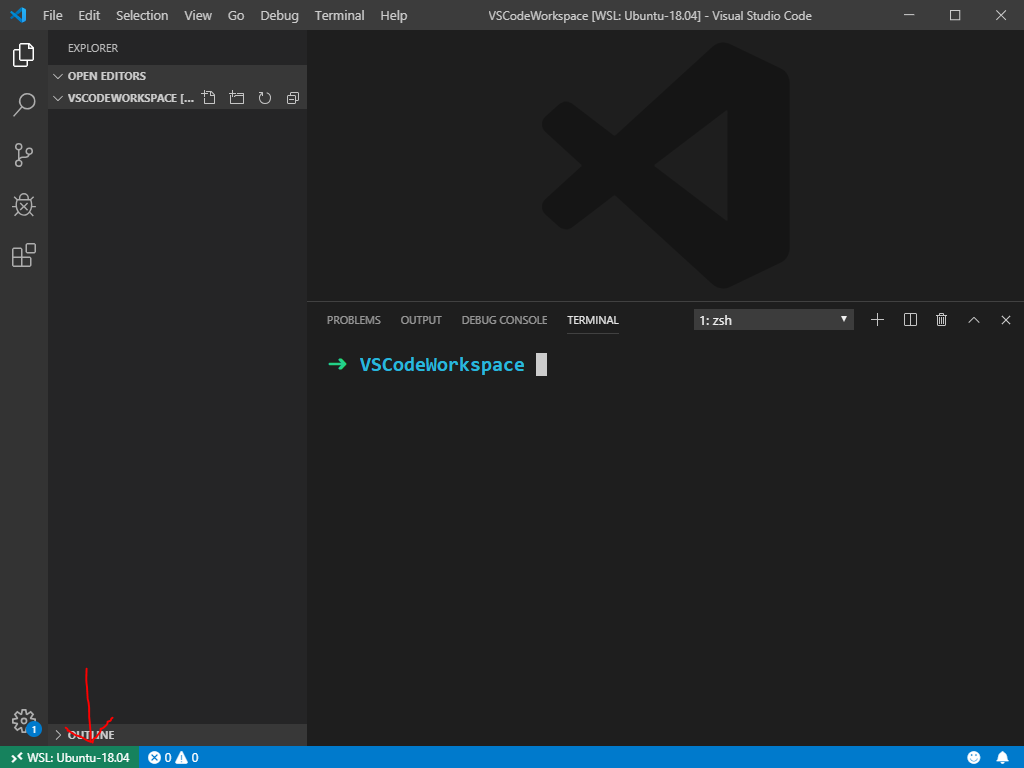
You tin even employ the built-in final to interact directly with the WSL workspace. At that place's no need to run a divide window for git fustigate commands.
Adding Windows Subsystem for Linux to the Windows Terminal
Another useful use-case of WSL is to add together the WSL panel information technology to the Windows Terminal.
From within Windows Terminal, you add each WSL distro in it'southward own tab. You tin can likewise customize the expect of each tab so you lot don't go lost.
If you're using a WSL distro that sets an environment variable for the user directory like UBUNTU_HOME, you tin can also set that every bit the starting directory for your terminal.
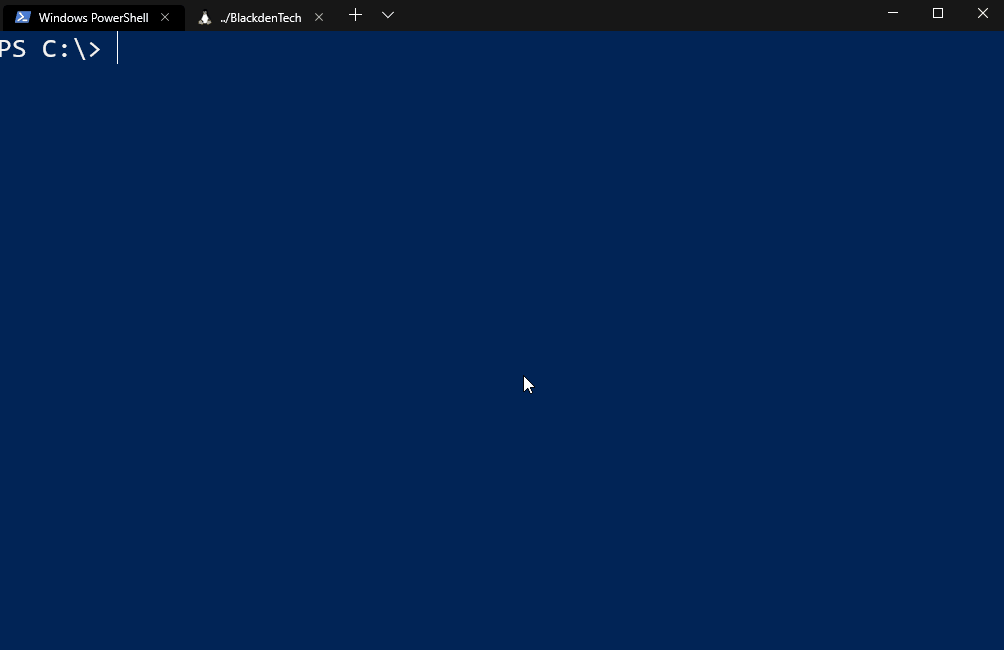
If you lot'd like a complete video walkthrough on setting upwards WSL to piece of work with the Windows Last, check out the TechSnips how-to video below.
Closing Thoughts
Microsoft released the WSL to allow Linux developers the ability to develop on Windows. And so far, the WSL has been a step in the right management.
It appears that the WSL is going to be a crucial component of Microsoft's new open-source friendly strategy. If Microsoft is going to take on Apple to exist the devices that developers write their code on, information technology's going to be an uphill battle. Simply WSL is a strong bill of fare to play.
WSL brings nearly many many welcome benefits to developers like:
- Significantly lighter weight than running local Linux VMs
- Removing the overhead of installing and managing a hypervisor
- No more requirement for multi-partitioned difficult drives
- No more complicated grub bootloaders
WSL just turns on and runs so we can all lawmaking happily e'er after.
joyalsarronever78.blogspot.com
Source: https://adamtheautomator.com/windows-subsystem-for-linux/
0 Response to "How Windows and Linux Can Work Together in Diverse Environments"
Post a Comment